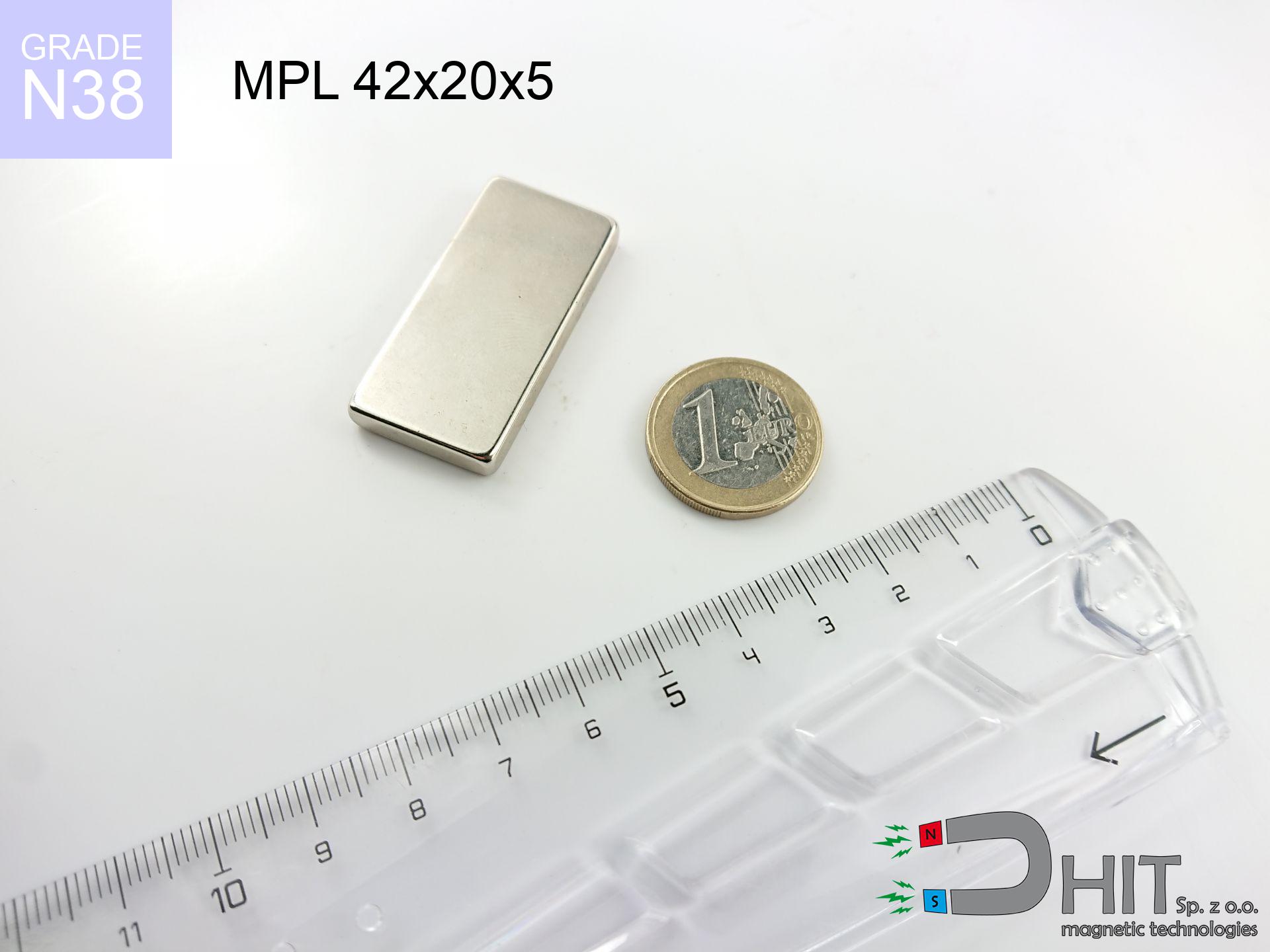BM 380x180x70 [4x M8] - magnetic beam
magnetic beam
Catalog no 090218
GTIN/EAN: 5906301812531
length
380 mm [±1 mm]
Width
180 mm [±1 mm]
Height
70 mm [±1 mm]
Weight
24400 g
4185.08 ZŁ with VAT / pcs + price for transport
3402.50 ZŁ net + 23% VAT / pcs
bulk discounts:
Need more?Looking for a better price?
Contact us by phone
+48 888 99 98 98
alternatively get in touch using
form
the contact section.
Strength as well as appearance of neodymium magnets can be verified with our
force calculator.
Same-day processing for orders placed before 14:00.
BM 380x180x70 [4x M8] - magnetic beam
Specification / characteristics BM 380x180x70 [4x M8] - magnetic beam
| properties | values |
|---|---|
| Cat. no. | 090218 |
| GTIN/EAN | 5906301812531 |
| Production/Distribution | Dhit sp. z o.o. |
| Country of origin | Poland / China / Germany |
| Customs code | 85059029 |
| length | 380 mm [±1 mm] |
| Width | 180 mm [±1 mm] |
| Height | 70 mm [±1 mm] |
| Weight | 24400 g |
| Manufacturing Tolerance | ±1 mm |
Physical properties of sintered neodymium magnets Nd2Fe14B at 20°C
| properties | values | units |
|---|---|---|
| Vickers hardness | ≥550 | Hv |
| Density | ≥7.4 | g/cm3 |
| Curie Temperature TC | 312 - 380 | °C |
| Curie Temperature TF | 593 - 716 | °F |
| Specific resistance | 150 | μΩ⋅cm |
| Bending strength | 250 | MPa |
| Compressive strength | 1000~1100 | MPa |
| Thermal expansion parallel (∥) to orientation (M) | (3-4) x 10-6 | °C-1 |
| Thermal expansion perpendicular (⊥) to orientation (M) | -(1-3) x 10-6 | °C-1 |
| Young's modulus | 1.7 x 104 | kg/mm² |
Elemental analysis
| iron (Fe) | 64% – 68% |
| neodymium (Nd) | 29% – 32% |
| boron (B) | 1.1% – 1.2% |
| dysprosium (Dy) | 0.5% – 2.0% |
| coating (Ni-Cu-Ni) | < 0.05% |
Ecology and recycling (GPSR)
| recyclability (EoL) | 100% |
| recycled raw materials | ~10% (pre-cons) |
| carbon footprint | low / zredukowany |
| waste code (EWC) | 16 02 16 |
Other deals
Strengths and weaknesses of Nd2Fe14B magnets.
Pros
- Their power remains stable, and after approximately ten years it drops only by ~1% (according to research),
- They are resistant to demagnetization induced by presence of other magnetic fields,
- By using a decorative layer of nickel, the element acquires an professional look,
- Magnetic induction on the top side of the magnet turns out to be very high,
- Thanks to resistance to high temperature, they can operate (depending on the shape) even at temperatures up to 230°C and higher...
- Possibility of individual modeling as well as adapting to individual conditions,
- Versatile presence in innovative solutions – they are used in mass storage devices, motor assemblies, advanced medical instruments, and technologically advanced constructions.
- Thanks to concentrated force, small magnets offer high operating force, with minimal size,
Cons
- Brittleness is one of their disadvantages. Upon intense impact they can break. We advise keeping them in a special holder, which not only protects them against impacts but also increases their durability
- NdFeB magnets lose power when exposed to high temperatures. After reaching 80°C, many of them experience permanent weakening of power (a factor is the shape as well as dimensions of the magnet). We offer magnets specially adapted to work at temperatures up to 230°C marked [AH], which are extremely resistant to heat
- When exposed to humidity, magnets start to rust. To use them in conditions outside, it is recommended to use protective magnets, such as magnets in rubber or plastics, which prevent oxidation and corrosion.
- Limited ability of making nuts in the magnet and complex shapes - recommended is a housing - magnet mounting.
- Health risk to health – tiny shards of magnets are risky, if swallowed, which gains importance in the aspect of protecting the youngest. It is also worth noting that tiny parts of these products can be problematic in diagnostics medical when they are in the body.
- With budget limitations the cost of neodymium magnets is economically unviable,
Holding force characteristics
Maximum lifting capacity of the magnet – what contributes to it?
- using a plate made of low-carbon steel, acting as a magnetic yoke
- whose transverse dimension reaches at least 10 mm
- with a plane perfectly flat
- with direct contact (without coatings)
- during pulling in a direction perpendicular to the mounting surface
- in temp. approx. 20°C
Lifting capacity in practice – influencing factors
- Gap between surfaces – every millimeter of distance (caused e.g. by veneer or dirt) diminishes the pulling force, often by half at just 0.5 mm.
- Loading method – declared lifting capacity refers to detachment vertically. When applying parallel force, the magnet holds significantly lower power (often approx. 20-30% of maximum force).
- Steel thickness – insufficiently thick steel causes magnetic saturation, causing part of the flux to be wasted into the air.
- Steel grade – ideal substrate is high-permeability steel. Cast iron may have worse magnetic properties.
- Surface quality – the more even the plate, the larger the contact zone and higher the lifting capacity. Roughness creates an air distance.
- Heat – neodymium magnets have a negative temperature coefficient. At higher temperatures they lose power, and in frost gain strength (up to a certain limit).
Holding force was checked on the plate surface of 20 mm thickness, when a perpendicular force was applied, whereas under parallel forces the lifting capacity is smaller. In addition, even a minimal clearance between the magnet’s surface and the plate decreases the lifting capacity.
Sensitization to coating
Nickel alert: The Ni-Cu-Ni coating consists of nickel. If skin irritation occurs, immediately stop handling magnets and use protective gear.
Compass and GPS
Note: rare earth magnets generate a field that confuses precision electronics. Keep a safe distance from your mobile, tablet, and navigation systems.
Respect the power
Handle magnets consciously. Their huge power can shock even experienced users. Stay alert and respect their force.
Cards and drives
Powerful magnetic fields can erase data on payment cards, HDDs, and storage devices. Maintain a gap of min. 10 cm.
Heat sensitivity
Standard neodymium magnets (N-type) lose magnetization when the temperature exceeds 80°C. The loss of strength is permanent.
Bone fractures
Watch your fingers. Two large magnets will snap together immediately with a force of massive weight, crushing everything in their path. Exercise extreme caution!
Danger to pacemakers
Patients with a ICD should maintain an absolute distance from magnets. The magnetism can disrupt the operation of the life-saving device.
Swallowing risk
Always keep magnets out of reach of children. Risk of swallowing is high, and the consequences of magnets connecting inside the body are very dangerous.
Material brittleness
Protect your eyes. Magnets can explode upon uncontrolled impact, launching sharp fragments into the air. Wear goggles.
Do not drill into magnets
Mechanical processing of neodymium magnets poses a fire hazard. Magnetic powder reacts violently with oxygen and is difficult to extinguish.

![Plate separator BM 380x180x70 [4x M8] Plate separator BM 380x180x70 [4x M8]](https://cdn3.dhit.pl/graphics/banners/magnet.webp)
![BM 380x180x70 [4x M8] - magnetic beam](https://cdn3.dhit.pl/graphics/products/bm-380x180x70-4x-m8-wex.jpg)
![UMGW 32x18x8 [M6] GW / N38 - magnetic holder internal thread UMGW 32x18x8 [M6] GW / N38 - magnetic holder internal thread](https://cdn3.dhit.pl/graphics/products/um32x18x8-m6-gw--hec.jpg)




